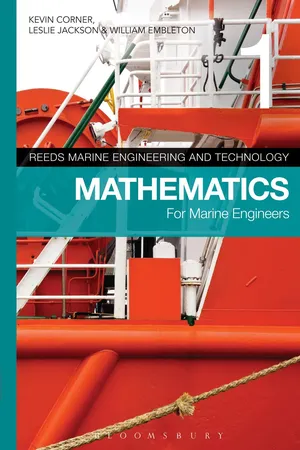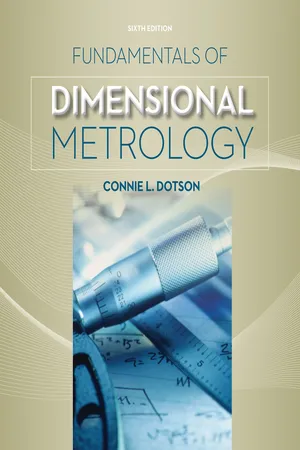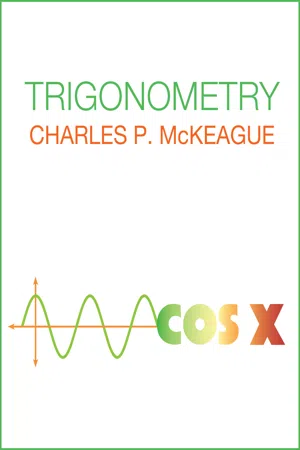Mathematics
Angle Measure
Angle measure refers to the amount of rotation between two rays that share a common endpoint, known as the vertex. It is typically measured in degrees, with a full rotation around a point equaling 360 degrees. Angles can be classified based on their measure, such as acute (less than 90 degrees), right (exactly 90 degrees), obtuse (greater than 90 degrees but less than 180 degrees), and straight (exactly 180 degrees).
Written by Perlego with AI-assistance
Related key terms
1 of 5
10 Key excerpts on "Angle Measure"
- Kevin Corner, Leslie Jackson, William Embleton(Authors)
- 2013(Publication Date)
- Thomas Reed(Publisher)
7 TRIGONOMETRY AND GEOMETRY An angle is the corner of two joining lines and the magnitude of an angle is measured in either degrees or radians. Measurement of Angles The most common unit of Angle Measurement that is known is probably the degree . There are 360 ◦ in a circle and so a degree is one three-hundred-and-sixtieth part of a circle. The symbol for a degree is ◦ and so there are 360 ◦ in a circle. Figure 7.1 shows a quarter of a circle which is 90 ◦ and is termed a right-angle , an angle which is less than 90 ◦ (Figure 7.2) is called an acute angle, greater than 90 ◦ but less than 180 ◦ (Figure 7.3) is an obtuse angle, and greater 180 ◦ (Figure 7.4) is a reflex angle. Right angle 90° Figure 7.1 142 • Mathematics Acute angle <90° Figure 7.2 90° < Obtuse angle < 180° Figure 7.3 Reflex angle >180° Figure 7.4 One sixtieth part of a degree is termed one minute and the sixtieth part of a minute is one second . Symbols are used to represent degrees, minutes and seconds. 60 s = 60 = 1 min; 60 min = 60 = 1 ◦ ; 360 ◦ = 1 circle. An angle of 35 degrees 23 minutes and 15 seconds is written as 35 ◦ 23 15 . Notation depends on the circumstance: some situations require angles to be given in decimal form accurate to, say, 3 decimal places; others require answers correct to the nearest tenth of one minute, for example 35 ◦ 25.7 ; and others may require an accuracy correct to the nearest second, for example 35 ◦ 23 15 . Circular measure A radian is the angle subtended at the centre of a circle by an arc equal in length to the radius (Figure 7.5). Trigonometry and Geometry • 143 Therefore 2 π radians = 360 ◦ 1 radian = 180 ◦ π ∼ = 57.3 ◦ or 57 ◦ 17 45 1 ◦ = π 180 ∼ = 0. 01745 radians r θ s A Figure 7.5 θ is in radians Length of arc, s = r · θ Area of sector, A = 1 2 · r 2 · θ Similarly, if a wheel of 0.3 m radius turns through 4 rad in 1 s, then a point on the rim moves at a rate of 4 × 0.3 = 1.2 m/s.- eBook - PDF
- Cynthia Y. Young(Author)
- 2018(Publication Date)
- Wiley(Publisher)
CONCEPTUAL OBJECTIVES ■ ■ Understand that degrees are a measure of an angle. ■ ■ Understand that degrees and radians are both units for measuring angles. ■ ■ Understand that rotation in the counterclockwise direction corresponds to a positive Angle Measure, whereas rotation in the clockwise direction corresponds to a negative Angle Measure. ■ ■ Understand that the measures of coterminal angles must differ by an integer multiple of 360 degrees. ■ ■ Understand why the angle in the arc length formula must be in radian measure. ■ ■ Understand that the central angle must be given in radians in order for the formula for the area of a circular sector to be used. ■ ■ Understand that linear speed has units of length/time and that angular speed has units of radians/time. ■ ■ Understand that angular speed and linear speed are related through the radius. 4.1 Angle Measure 4.1 Angle Measure 347 The Greek letter u (theta) is the most common name for an angle in mathematics. Other common names of angles are a (alpha), b (beta), and g (gamma). WORDS MATH 360° represents 1 complete counterclockwise rotation. 360° 360° 5 1 180° represents a 1 2 counterclockwise rotation. 180° 360° 5 1 2 90° represents a 1 4 counterclockwise rotation. 90° 360° 5 1 4 1° represents a 1 360 counterclockwise rotation. 1° 360° 5 1 360 WORDS MATH An angle measuring exactly 90° is called a right angle. A right angle is often represented by the adjacent sides of a rectangle, indicating that the two rays are perpendicular. An angle measuring exactly 180° is called a straight angle. An angle measuring greater than 0°, but less than 90°, is called an acute angle. An angle measuring greater than 90°, but less than 180°, is called an obtuse angle. If the sum of the measures of two positive angles is 90°, the angles are called complementary. We say that a is the complement of b (and vice versa). If the sum of the measures of two positive angles is 180°, the angles are called supplementary. - eBook - PDF
- Cynthia Y. Young(Author)
- 2021(Publication Date)
- Wiley(Publisher)
Point A is called the endpoint of the ray. In geometry, an angle is formed when two rays share the same endpoint. The common endpoint is called the vertex. In trigonometry, we say that an angle is formed when a ray is rotated around its endpoint. The ray in its original position is called the 1.1 Angles, Degrees, and Triangles 3 initial ray or the initial side of an angle. In the Cartesian plane (the rectangular coordinate plane), we usually assume the initial side of an angle is the positive x-axis and the vertex is located at the origin. The ray after it is rotated is called the terminal ray or the terminal side of an angle. Rotation in a counterclockwise direction corresponds to a positive angle, whereas rotation in a clockwise direction corresponds to a negative angle. Negative angle Terminal side Initial side Positive angle Terminal side Initial side Lengths, or distances, can be measured in different units: feet, miles, and meters are three common units. To compare angles of different sizes, we need a standard unit of measure. One way to measure the size of an angle is with degree measure. We discuss degrees now, and in Chapter 3, we discuss another Angle Measure called radians. Words Math 360° represents 1 complete rotation. 1 complete rotation = 1 · 360° = 360° 180° represents 1 _ 2 rotation. 1 _ 2 complete rotation = 1 _ 2 · 360° = 180° 90° represents 1 _ 4 rotation. 1 _ 4 complete rotation = 1 _ 4 · 360° = 90° The Greek letter θ (theta) is the most common name for an angle in mathematics. Other common names for angles are α (alpha), β (beta), and γ (gamma). Words Math An angle measuring exactly 90° is called a right angle. A right angle is often represented by the adjacent sides of a rectangle, indicating that the two rays are perpendicular. An angle measuring exactly 180° is called a straight angle. - eBook - PDF
- Ron Larson(Author)
- 2017(Publication Date)
- Cengage Learning EMEA(Publisher)
For example, in Exercise 68 on page 131, you will use angles and their measure to model the distance a cyclist travels. Connel/Shutterstock.com Copyright 2018 Cengage Learning. All Rights Reserved. May not be copied, scanned, or duplicated, in whole or in part. Due to electronic rights, some third party content may be suppressed from the eBook and/or eChapter(s). Editorial review has deemed that any suppressed content does not materially affect the overall learning experience. Cengage Learning reserves the right to remove additional content at any time if subsequent rights restrictions require it. 1.1 Radian and Degree Measure 123 Radian Measure The amount of rotation from the initial side to the terminal side determines the measure of an angle. One way to measure angles is in radians. This type of measure is especially useful in calculus. To define a radian, use a central angle of a circle, which is an angle whose vertex is the center of the circle, as shown in Figure 1.5. Definition of a Radian One radian (rad) is the measure of a central angle θ that intercepts an arc s equal in length to the radius r of the circle. (See Figure 1.5.) Algebraically, this means that θ = s r where θ is measured in radians. (Note that θ = 1 when s = r.) The circumference of a circle is 2π r units, so it follows that a central angle of one full revolution (counterclockwise) corresponds to an arc length of s = 2π r. Moreover, 2π ≈ 6.28, so there are just over six radius lengths in a full circle, as shown in Figure 1.6. The units of measure for s and r are the same, so the ratio sH20862r has no units—it is a real number. The measure of an angle of one full revolution is sH20862r = 2π rH20862r = 2π radians, so you can obtain the following. 1 2 revolution = 2π 2 = π radians 1 4 revolution = 2π 4 = π 2 radians 1 6 revolution = 2π 6 = π 3 radians These and other common angles are shown below. - eBook - PDF
- Cynthia Y. Young(Author)
- 2023(Publication Date)
- Wiley(Publisher)
• Solve right triangles. • Define trigonometric functions as ratios of x- and y-coordinates and distances in the Cartesian plane. • Evaluate trigonometric functions for nonacute angles. • Relate degree and radian measure. • Solve oblique triangles using the Law of Sines. • Solve oblique triangles using the Law of Cosines. 352 CHAPTER 4 Trigonometric Functions of Angles Negative angle Terminal side Initial side Positive angle Terminal side Initial side Lengths, or distances, can be measured in different units: feet, miles, and meters are three common units. To compare angles of different sizes, we need a standard unit of measure. One way to measure the size of an angle is with degree measure. Words Math 360° represents 1 complete rotation. 1 complete rotation = 1 · 360° = 360° 180° represents 1 _ 2 rotation. 1 _ 2 complete rotation = 1 _ 2 · 360° = 180° 90° represents 1 _ 4 rotation. 1 _ 4 complete rotation = 1 _ 4 · 360° = 90° The Greek letter θ (theta) is the most common name for an angle in mathematics. Other common names for angles are α (alpha), β (beta), and γ (gamma). An angle formed by one complete counterclockwise rotation has measure 360 degrees, denoted 360°. One complete revolution = 360º Therefore, a counterclockwise 1 ___ 360 of a rotation has measure 1 degree. Degree Measure of Angles STUDY TIP Greek letters are often used to denote angles in trigonometry. 4.1.1 Angles and their Measure 4.1.1 Skill Find the complement and supplement of an angle. 4.1.1 Conceptual Understand that degrees are a measure of an angle. The ray in its original position is called the initial ray or the initial side of an angle. The common endpoint is called the vertex. An angle is formed when a ray is rotated around its endpoint. In the Cartesian plane (the rectangular coordinate plane), we usually assume the initial side of an angle is the positive x-axis and the vertex is located at the origin. - eBook - PDF
- Ron Larson(Author)
- 2021(Publication Date)
- Cengage Learning EMEA(Publisher)
All Rights Reserved. May not be copied, scanned, or duplicated, in whole or in part. Due to electronic rights, some third party content may be suppressed from the eBook and/or eChapter(s). Editorial review has deemed that any suppressed content does not materially affect the overall learning experience. Cengage Learning reserves the right to remove additional content at any time if subsequent rights restrictions require it. 4.1 Radian and Degree Measure 261 GO DIGITAL Radian Measure The amount of rotation from the initial side to the terminal side determines the measure of an angle. One way to measure angles is in radians. This type of measure is especially useful in calculus. To define a radian, use a central angle of a circle, which is an angle whose vertex is the center of the circle, as shown in Figure 4.5. The circumference of a circle is 2π r units, so it follows that a central angle of one full revolution (counterclockwise) corresponds to an arc length of s = 2π r. Moreover, 2π ≈ 6.28, so there are just over six radius lengths in a full circle, as shown in Figure 4.6. The units of measure for s and r are the same, so the ratio sr has no units—it is a real number. The measure of an angle of one full revolution is sr = 2π rr = 2π radians. Here are the measures of some other angles. 1 2 revolution = 2π 2 = π radians 1 4 revolution = 2π 4 = π 2 radians 1 6 revolution = 2π 6 = π 3 radians 1 8 revolution = 2π 8 = π 4 radians These and other common angles are shown below. π 6 π 4 π 3 π 2 π π 2 Recall that the four quadrants in a coordinate system are numbered I, II, III, and IV. The figure below shows which angles between 0 and 2π lie in each of the four quadrants. An angle whose terminal side lies on the x- or y-axis, such as 0, π 2, π , or 3π 2, is a quadrantal angle. The terminal sides of quadrantal angles do not lie within quadrants. Note that angles between 0 and π 2 are acute angles and angles between π 2 and π are obtuse angles. - No longer available |Learn more
- Alfred Basta, Stephan DeLong, Nadine Basta, , Alfred Basta, Stephan DeLong, Nadine Basta(Authors)
- 2013(Publication Date)
- Cengage Learning EMEA(Publisher)
Right-Triangle Geometry and Trigonometry Chapter 7 7.1 M EASURING AN A NGLE 7.2 T RIGONOMETRIC F UNCTIONS 7.3 R IGHT T RIANGLES ne of the most frequently applied concepts of geometry is that of a right triangle , which is a triangle containing a 90° angle at one vertex. The right triangle holds an important place as a corner-stone of the study of trigonometry, a field whose name (taken literally) means the study of triangles and that is the object of our interest in this chapter. Finding its roots in ancient Greece, trigonometry had its beginnings as the computational aspect of geom-etry and found application as a tool to measure ob-jects from a distance. What distinguishes trigonometry from geometry is that it is based on the measurements of angles and also on particular quantities determined by those measurements, while geometry is a study of shapes and of measurements of the Earth. The measures of shapes (side lengths, areas, perimeters, and so on) are determined using any of our well-known scales of measurement, such as inches, feet, meters, and so on. Angles, on the other hand, can be measured using two distinct scales, one being the rather familiar form of degrees, the other the less well-known system of radians. These Angle Measurements (whatever the form) are related to the lengths of the sides of triangles by the trigonometric functions of sine, cosine, tangent, and others, and we will introduce these in this chapter. Note that trigonometric functions are not nearly as straightforward to work with as are the algebraic func-tions with which we have already gained experience. Copyright 2013 Cengage Learning. All Rights Reserved. May not be copied, scanned, or duplicated, in whole or in part. Due to electronic rights, some third party content may be suppressed from the eBook and/or eChapter(s). Editorial review has deemed that any suppressed content does not materially affect the overall learning experience. - eBook - PDF
- Connie Dotson(Author)
- 2015(Publication Date)
- Cengage Learning EMEA(Publisher)
The notation is familiar: degrees (°), minutes (‘), and seconds (‘‘); the latter two, unfortu-nately, can be confused with feet and inches. To give you an idea how fine the discrimination of this angu-lar notation system is: one second of an arc subtends a distance equal to the height of a basketball 46.671 km (29 miles) away, and the same arc subtends 1.8507 km (1.15 miles) on the moon. Today, we do use some other Angle Measurements— for example, the radian is the angle subtended by an arc of circle that is equal to the radius of the circle. We use this measurement chiefly for dealing with angular dis-placement, like gear rotations. You will commonly find decimal divisions of the degree, used both in indus-try and science, and you can easily find these decimal divisions with any scientific calculator. We will focus this chapter on the principles of right triangle trigonometry and the measurement of angles based on the circle. 12–1 ANGLES We will mention a few basics about angles before we go on to Angle Measurement. First, angles deal with directions—not spaces— because an angle is the relationship between two lines (see Figure 12–2). We can measure this relationship if we extend the lines until they intersect. The intersec-tion is called the vertex, and the lines are sides. We can conveniently designate an angle using three letters, AOB in our example, and, frequently, we use the sym-bol ∠ to designate an angle, such as ∠ ABC. We do FIGURE 12–2 The angle is defined as AOB. It refers to the directions of the sides, not to the space between them. Copyright 2016 Cengage Learning. All Rights Reserved. May not be copied, scanned, or duplicated, in whole or in part. Due to electronic rights, some third party content may be suppressed from the eBook and/or eChapter(s). Editorial review has deemed that any suppressed content does not materially affect the overall learning experience. - eBook - PDF
- Bernard Kolman, Arnold Shapiro(Authors)
- 2014(Publication Date)
- Academic Press(Publisher)
In this case, we say that fi is a negative angle. If the terminal side coincides with a coordinate axis, then the angle is called a quadrantal angle; otherwise, the angle is said to lie in the same quadrant as its terminal side. There are two commonly used units for measuring angles. An angle is said to have a measure of one degree (written 1°) if the angle is formed by rotating the initial side aeoth of a complete rotation in a counterclockwise direction (Figure 2). Thus, an angle obtained by a complete rotation of the initial side has a measure of 360°, and an angle obtained by one fourth of a complete rotation has a measure of (360°) = 9(F. One degree is subdivided into 60 minutes (written 60'), and one minute is subdivided into 60 seconds (written 60). Thus, the notation 14°24'18 is read 14 degrees, 24 minutes, and 18 seconds. An angle between 0° and 90° lies in the first quadrant and is i iy i° 1 X FIGURE 2 246 ANGLES AND TRIANGLES called an acute angle; an angle between 90° and 180° lies in the second quadrant and is called an obtuse angle. An angle measuring 90° is a quad-rantal angle and is called a right angle; angles measuring 180° and 270° are also quadrantal angles. To define the second unit of angular measurement, consider an angle 0 in standard position and let P be the point of intersection of the terminal side of the angle with the unit circle (Figure 3). We may think of P as the point p =wtoV ( ^ ^ ^ * SY aw j ■ FIGCIRE3 assigned by the wrapping function for some real number t, that is, P = W(t). We then say that 0 is an angle of t radians, by which we mean that the measure of the angle 0 is defined as the measure of the arc that 0 intercepts on the unit circle. We then write 0 = t radians or simply 0 = t. The radian measure of angles of 1 radian, -2 radians, and 3TT/4 radians are shown in Figure 4a, 4b, and 4c, respectively. - eBook - PDF
- Charles P. McKeague(Author)
- 2020(Publication Date)
- XYZ Textbooks(Publisher)
As you will see, specifying the measure of an angle with radian measure gives us a way to associate the measure of an angle with real numbers, rather than degrees. A Radian Measure To understand the definition for radian measure, we have to recall from geometry that a central angle is an angle with its vertex at the center of a circle. FIGURE 1 θ O r r Angle θ has a measure of 1 radian The vertex of θ is at the center of the circle; the arc cut off by θ is equal in length to the radius Note It is common practice to omit the word radian when using radian measure. If no units are showing, an angle is understood to be measured in radians; with degree measure, the degree symbol ° must be written. θ = 2 means the measure of θ is 2 radians θ = 2° means the measure of θ is 2 degrees To find the radian of any central angle, we must find how many radii there are in the arc it cuts off. To do so, we divide the arc length by radius. If the radius is 2 centimeters and the arc cut off by central angle θ is 6 centimeters, then the radian measures of θ is _ 6 = 3 radians. 2 Definition In a circle, a central angle that cuts off an arc equal in length to the radius of the circle has a measure of 1 radian. That is, in a circle of radius r , a central angle that measures 1 radian will cut off an arc of length r (Figure 1). 132 Chapter 3 Radian Measure Here is the formal definition: Definition If a central angle θ in a circle of radius r cuts off an arc of length s , then the measure of θ in radians is given by _ s r . (See Figure 2.) FIGURE 2 θ O r s θ (in radians) = s r 3.2 Videos Example 1 A central angle θ in a circle of radius 3 centimeters cuts off an arc of length 6 centimeters. What is the radian measure of θ ? FIGURE 3 θ 3 cm 6 cm Solution We have r = 3 centimeters and s = 6 centimeters, therefore, s θ (in radians) = _ r 6 cen = ___________ timeters 3 centimeters = 2 We say the radian measure of θ is 2 or θ = 2 radians.
Index pages curate the most relevant extracts from our library of academic textbooks. They’ve been created using an in-house natural language model (NLM), each adding context and meaning to key research topics.









